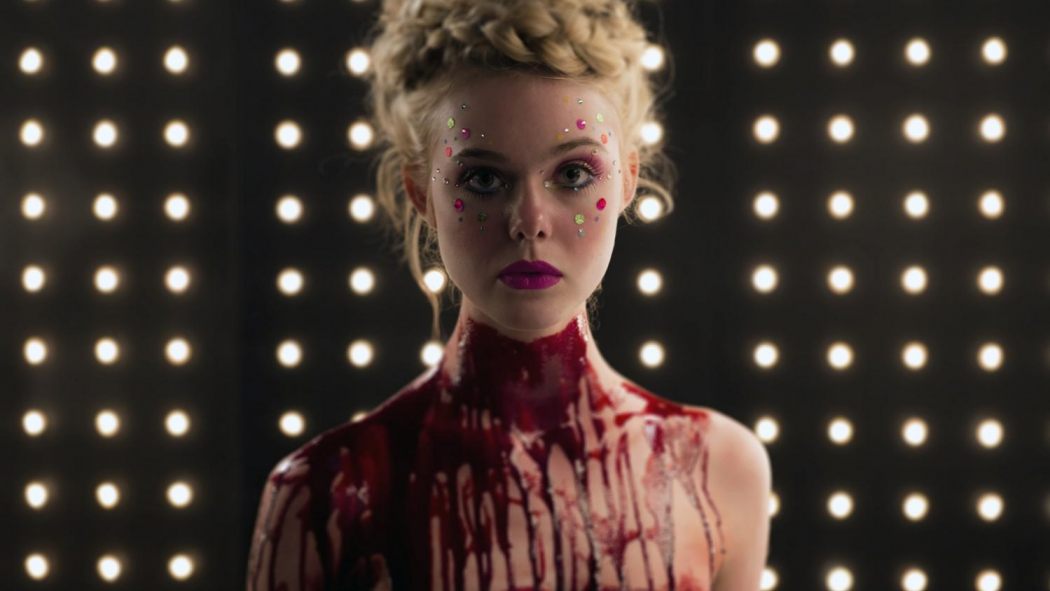This guest post is written by Holly Thicknes.
[Trigger warning: discussion of rape and rape culture]
The Neon Demon threw up a lot of questions when it regurgitated Elle Fanning’s eyeball.
Yes, Nicolas Winding Refn made a surrealistic film about a 16 year old It-Girl model who gets slowly engulfed by the horrific monster that is the fashion industry via a bunch of envious flesh-eating model competitors. It’s the Donald Trump card of controversy at cinemas right now. But it also – pretty neatly, despite its gory appearance – epitomizes a society that is at once compelled and revolted by its need to consume.
Refn is obviously obsessed with women. He’s in awe of them. He thinks they’re intangibly beautiful. His entire filmic career can be seen as an expression of his distraction with how the female body differs from the male, and how that inspires violence. Jealousy, protectiveness, impotency: it’s all there in the scopophilic text of his films, skirting around the ankles of his uber-masculine figurines that dance perfect executions of violent, sexual acts.
It’s no wonder his latest film, a departure from the likes of Drive and Only God Forgives in that its central character is a woman, but in which his obsession shines through stronger than ever, has been deemed by many a gross, misogynistic ululation, or else pure unashamed spectacle. I can’t help but wonder if, had a heterosexual woman made a neo-porn movie detailing all of her perverse, beautiful desires, anyone would be eager to finance it. But I don’t begrudge Refn for making it, just as I don’t begrudge Hitchcock’s unapologetic spunking of his inner most fantasies on cinema’s walls. It’s not about limiting human creativity, censoring what could be deemed a negative influence or pointing the finger at what someone truly feels.
The Neon Demon brings to light the dual narcissism of our culture: the simultaneous, reciprocal reality created when consumers come into contact with images. The images exist so long as we look at them, and all Refn has done is reify our culture’s unhealthy obsession – what he himself is unhealthily obsessed with.
I’m glad for The Neon Demon, because it solidifies something that was already there: a hundred ornate mirrors reflecting back a society complicit in rape culture.
Reducing someone to an object makes it easier to harm them. More than this — it incites violence. Rape culture is a culture that dehumanizes. It normalizes rape and abuse while simultaneously blaming rape and sexual assault victims/survivors for their actions and behaviors.
This is embedded in the fabric of The Neon Demon. It sets up a gorgeously glowing, electronically scored, Americana world in which beauty “isn’t everything – it’s the only thing,” and women strive to mold themselves into non-human visions. The predatory danger of this nightmarish place, which young Jesse (Elle Fanning) is so keen to be part of, is crucial to the first part of the film, in which Keanu Reeves plays a rapist motel owner by the name of Hank, preying on young disenfranchised girls who are forced to live there. As Jesse presses her ear to the wall of her room and listens to the 13-year-old girls being raped next door with tears streaming down her face, the margins of her power close tightly around her. She is reduced to nothing but a porcelain doll – her beauty and youth her only bargaining tools of worth.
But, alas, every effort the first half of the film makes to incredulously depict moments of degradation and objectification – so promisingly linked directly to rape in the above scene — melts into nothing. It is disappointingly superseded by what it sees, like a magpie destined to be drawn from one shiny artifact to the next. Refn gets entirely distracted by the surface of the movie, pushing the mesmerizing spectacle to its all-consuming limit and in doing so, dissolving all of its efforts towards saying something interesting, memorable and, crucially, progressive.
Perhaps it is enough to address the link between objectification and rape at all, and Refn’s second-act descent into style obsession — there are some painfully drawn-out shots of pure fantasy indulgence — only reiterates his pointing out how far our image illness has gone. But somehow, I don’t think so. I feel it has the effect of switching off swaths of audiences who find themselves in the middle of one of Refn’s wet dreams. The film negates its previous commentary by becoming hypnotized by its own evil.
We cannot blame Refn for articulating an ugly truth. We are all complicit in our culture. If the eyeball-eating scene is the only one that survives The Neon Demon, let it be not for its shock factor, but because it fills us with as much disgust as do rape culture and our own mass consumption of women’s bodies.
Holly Thicknes is a freelance film critic and editor of female-focused film blog Girls On Film. She lives and works in London, studies printmaking, and helps organize themed short film events for Shorts On Tap. She is particularly interested in the ways in which films help people carve out spaces for themselves in an increasingly lonely society. You can follow Girls On Film on Twitter @girlsonfilmLDN.


